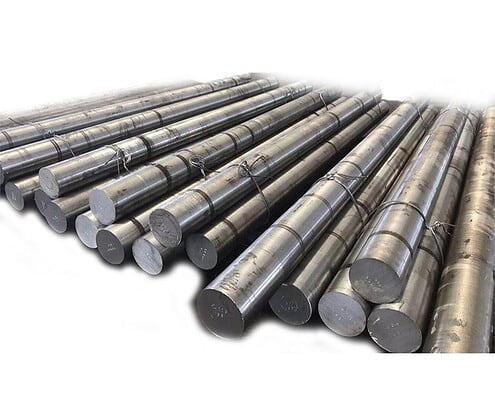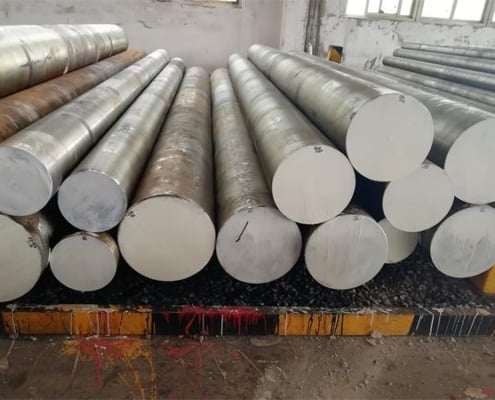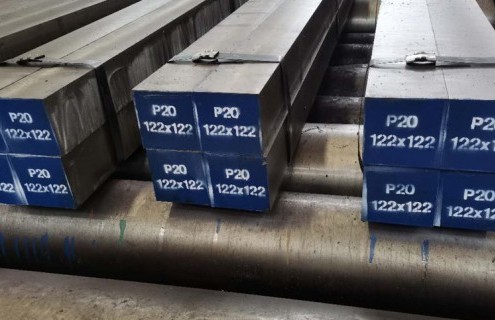L6 Steel | AISI L6 | 1.2714 | SKT4
WALDUN is a Chinese topL6 Steel Manufacturer and Exporter, can supply with round,square,flat,block,and shaft etc.
L6 steel comprehensive mechanical properties are good, high hardenability, can make the cross-sectional size of steel to obtain a more uniform hardness.
L6 steel has a very good throw spin performance, made of mold surface 90 roughness value is low. With the steel manufacturing mold generally first tempering treatment, hardness of 52 ~ 62HRC (i.e. pre-hardening), after the cold processing made of mold can be used directly, so as to ensure the use of the mold performance, but also to avoid the heat treatment caused by the deformation of the mold.
AISI L6 is defined as Cr-Ni-Mo alloyed hot work tool steel as per ASTM A681.it is equivalent with Germany grade 1.2714/55NiCrMoV7.AISI L6 has good resistance to thermal shock and heat cracking,good mechanical characteristics and toughness in hot and cold conditions,good resistance to the tempering.It is normally supply in hardened, quenched & tempered condition, and also in annealed condition in special case.AISI L6 Steel can maintain hardness above 60 HRC for sections of 75 mm (3 in.) thickness.
L6 steel Supply Form & Size & Tolerance
| Supply Form | Size(mm) | Process | Tolerance | |
| Round | Φ6-Φ100 | Cold Drawn | Bright/Black | Best H11 |
| Φ16-Φ350 | Hot Rolled | Black | -0/+1mm | |
| Peeled/ground | Best H11 | |||
| Φ90-Φ1000 | Hot Forged | Black | -0/+5mm | |
| Rough Turned | -0/+3mm | |||
| Flat/Square/Block | Thickness :120-800 | Hot Forged | Black | -0/+8mm |
| Width:120-1500 | Rough Machined | -0/+3mm | ||
Remark:Tolerance can be customized as per requests
L6 steel Chemical Composition
| Standard | Grade | C | Si | Mn | P | S | Cr | Ni | Mo | V |
| ASTM A681 | L6 | 0.65-0.75 | 0.1-0.5 | 0.25-0.80 | 0.03 | 0.03 | 0.6-1.2 | 1.25-2.0 | 0.50 | — |
| DIN EN ISO 4957 | 1.2714 | 0.50-0.60 | 0.1-0.4 | 0.60-0.90 | 0.03 | 0.02 | 0.8-1.2 | 1.50-1.8 | 0.35-0.55 | 0.05-0.15 |
| 55NiCrMoV7 | ||||||||||
| JIS G4404 | SKT4 | 0.50-0.60 | 0.1-0.4 | 0.60-0.90 | 0.03 | 0.02 | 0.8-1.2 | 1.50-1.8 | 0.35-0.55 | 0.05-0.15 |
L6 steel Physical Property
| Density,kg/dm3 | 7.8 |
| Specific heat capacity,J/g.K | 0.46 |
| Thermal conductivity ,W/m.K | 35.9 |
| Specific electric resist,Ohm mm2/m | 0.3 |
| Electrical conductivity,m/mm2 | 3.33 |
| Modulus of elasticity long.,Gpa | 215 |
| Modulus of elasticity tang.,Gpa | 82 |
L6 steel Thermal Property
| Temperature,°C | 20-100 | 20-200 | 20-300 | 20-400 | 20-500 | 20-600 | 20-700 |
| Thermal expansion,10^-6 m/(m*K) | 12.5 | 13.1 | 13.4 | 13.9 | 14 | 14.3 | 14.5 |
| Temperature,°C | 20 | 350 | 700 | ||||
| Thermal Conductivity,W/(m*K) | 35 | 39 | 36 | ||||
L6 steel Mechanical Property
| Quenching at 860 °C in oil | Tempering | 100°C | 150°C | 200°C | 250°C | 300°C | 350°C | 400°C | 450°C | 500°C | 550°C | 600°C | 650°C |
| HB | 634 | 615 | 595 | 577 | 543 | 512 | 482 | 468 | 442 | 409 | 390 | — | |
| HRC | 59 | 58 | 57 | 56 | 54 | 52 | 50 | 49 | 47 | 44 | 42 | — | |
| R,N/mm 2 | 2420 | 2330 | 2240 | 2160 | 2010 | 1880 | 1760 | 1700 | 1580 | 1430 | 1340 | — | |
| Quenching at 860 °C in air | Tempering | 100°C | 150°C | 200°C | 250°C | 300°C | 350°C | 400°C | 450°C | 500°C | 550°C | 600°C | 650°C |
| HB | 560 | — | 512 | — | 482 | — | 442 | 421 | 400 | 371 | 336 | 301 | |
| HRC | 55 | — | 52 | — | 50 | — | 47 | 45 | 43 | 40 | 36 | 32 | |
| R,N/mm 2 | 2070 | — | 1880 | — | 1760 | — | 1580 | 1480 | 1390 | 1250 | 1110 | 1010 |
L6 steel Forging
Heat the temperature to 750 oC – 800 oC ,hold for suitable time,then heat the temperature up to 1050oC,hold enough time for the steel to be thoroughly heated.Don’t forge below 850oC.AISI L6 steel should be cooled as slowly as possible in the furnance.Annealing is strongly recommended after forged.
L6 steel Annealing
Annealing must be performed after hot working and before re-hardening.Heat the temperature to740- 760°C with a rate not exceeding 220°C per hour , and hold at temperature for 1 hour per inch (25.4mm) of maximum thickness; 2 hours minimum. Then cool slowly with the furnace at a rate not exceeding 20°C per hour to 500°C. Continue cooling to ambient temperature in the furnace or in air. The resultant hardness should be a maximum of 235 HBW.
L6 steel Hardening
Prheat uniformly to the temperature 650-700°C ,Quench in air with hardening temperature 870-900°C,or quench in oil with with hardening temperature 830-870°C,tempering should be followed as soon as possible.
L6 steel Tempering
Heat uniformly to the required temperature allowing a soaking time of two hours per 25mm of ruling section. Withdraw from the furnace and allow to cool in air. A second tempering is highly recommended, the tool being allowed to cool to room temperature between tempers.
| Temperature ,°C | 200 | 250 | 300 | 400 | 500 |
| Hardness , HRC | 55 | 54 | 53 | 49 | 45 |
L6 steel Application
AISI L6 is highly recommendable for Close Die Forgings due to its characteristics of high wear-resistance, extra toughness , high hardness which is achieved with Cr-Ni-Mo-V high graded alloys.
Typical applications includes Arbors, blanking dies, clutch parts, forming dies,disc saws, drift pins, brake dies, hand stamps,hubs, lead and feed screws, machine parts,punches, pawls, pinions, shear blades, spindles,spring collets, swages and etc.
L6 Steel Buying Guide
Can’t find the best and the most effective L6 steel buying guide to help you in your journey? Fret not because in this guide, we will teach you every bit of information about L6 steel you need to know!
By the end of this guide, you’ll be an expert in distinguishing L6 steel from other types of steel. Furthermore, you’ll also have knowledge on how to choose the best Chinese L6 steel manufacturer!
What is L6 Steel?
L6 steel is the steel you can bank and rely on if you’re looking for steels that have high levels of impact and shock resistance.
L6 steel round bars getting readied and prepared for usage
It’s a type of steel that’s oil-hardened, which means it’s processed via being heated and cooled while submerged in oil, unlike air hardening.
L6 Steel vs. T10 Steel
L6 steel is a type of oil-hardened special purpose steel that’s tough and durable compared to other of its counterparts.
Example of what T10 steels are
It contains good levels of non-deforming characteristics, as well as high levels of strength.
T10 steel, on the other hand, is the type of steel that’s made from a mixture of tungsten and carbon steel. Unlike L6 steel, T10 steel is more of a modern-type of steel as it utilizes all of the elements present for its features and functionalities.
When it comes to hardness, both the L6 and T10 can reach and maintain levels of hardness that are upwards of 60 HRC.
T10 steel is a type of Chinese tool steel that possesses moderate levels of strength and toughness and is cheap. L6 steel, on the other hand are considered to be at above-moderate levels of hardness and durability.
Where to Buy L6 Steel?
Unlike other types of steel, L6 steel is a type of steel you can easily purchase from the market.
You’ll be able to find L6 steels anywhere!
You can find many different kinds and classifications of L6 steel from various countries and regions worldwide.
Should you be looking for the best and the highest quality of L6 steel, then choosing a Chinese L6 steel supplier would be what you need.
Apart from the fact that you’ll find their rates and prices cheaper, you can also make use of the material availability characteristic that all suppliers and manufacturers possess.
What Can You Use L6 Steel For?
Originally, you would choose L6 steels if you were to make swords, blades, knives, and other multi-purpose products.
You can use L6 steel for different kinds and types of tools!
Now, though, you can find use of L6 steels in a lot of other industries and sectors.
Since it’s “special purpose,” you can use L6 steels for a vast range of applications, including:
- Rollers
- Chuck Parts
- Bearings
- Springs
- Boasters,
- Plastic Molds
- Shafts
- Forging Hammers
- Mechanical Dies and Presses
- Shoe Blocks
- And Many More!
As you can see, the usage of L6 steel isn’t just compressed to that of blades. In fact, you can use it for shoe blocks, shafts, springs, bearings, and other passive parts and components as well!
Materials Equivalent to L6 Steel Tools
If you ever find yourself short of the L6 tool steels you need, you can consider using the following materials for your tools:
- SAE J438
- DIN 1.2713
- ASTM AS681
- UNS T61206
- SAE J437
Do You Need to Use L6 Steel?
L6 steel’s history is one for the books. As a matter of fact, its first entry was a few years back; it was used for knives, swords, and other types of blades.
L6 steel is the most useful in sharp and tough applications
In addition to that, L6 steel’s capability of being weldable made it one of the most sought-after types of steel for multi-purpose uses.
You would want to choose an L6 steel if you are looking for tough and durable steel with only low levels of carbon in it. Furthermore, you’ll be able to find use of its combined hardness and impact resistance.
Advantages of Using L6 Steel
If you’re torn between choosing L6 steel and another type of steel, here are some of the advantages and the benefits that you can consider:
- Low distortion during heat treatment, thanks to low carbon content
- Good levels of wear resistance
- High hardness and toughness levels
- When annealed to Brinell 217, L6 steel’s machinability is easier
- Has non-deforming and safe-hardening properties
Disadvantages of Using L6 Steel
The following are the drawbacks of choosing L6 steel for your application:
- Corrosion resistance isn’t that good compared to other types of steel
- Has higher machinability but slightly lower hardness and toughness
- Reduced weldability
Where Can You Find High Quality L6 Steels?
If you think you’ll be able to find the best L6 steels in Europe or in the U.S., think again! China is the place where you can find the L6 steel that has the most value, the highest quality, and the most treated.
Out of all the many L6 steel manufacturers in the country, no other supplier is trusted but us here at Waldun Steel.
We’ve been the one-stop solution of businesses looking for L6 steels worldwide. Wherever your business is, you can bank and rely on us to help you in producing and manufacturing the L6 steels you need!
If you need pre-made or custom L6 steels, we’re just a call or an email away!
Why Work With Waldun Steel?
For years, Waldun Steel never failed in meeting – even exceeding the expectations of businesses and organizations when it comes to whatever steel they need.
Whether you need to purchase L6 steel in retail or in wholesale, you can rely and count on us! We’ll give you a free quotation or a free estimate of the products you’ll be ordering!
Other Related Steel Products
Page Contents
- L6 steel Supply Form & Size & Tolerance
- L6 steel Chemical Composition
- L6 steel Physical Property
- L6 steel Thermal Property
- L6 steel Mechanical Property
- L6 steel Forging
- L6 steel Annealing
- L6 steel Hardening
- L6 steel Tempering
- L6 steel Application
- L6 Steel Buying Guide
- What is L6 Steel?
- L6 Steel vs. T10 Steel
- Where to Buy L6 Steel?
- What Can You Use L6 Steel For?
- Materials Equivalent to L6 Steel Tools
- Do You Need to Use L6 Steel?
- Advantages of Using L6 Steel
- Disadvantages of Using L6 Steel
- Where Can You Find High Quality L6 Steels?
- Why Work With Waldun Steel?
- Other Related Steel Products















